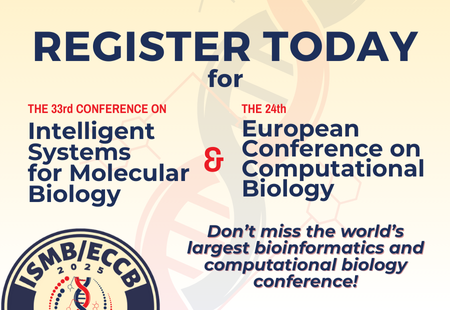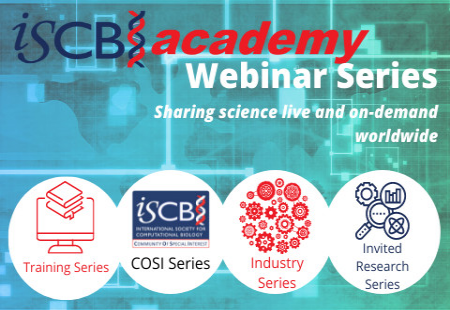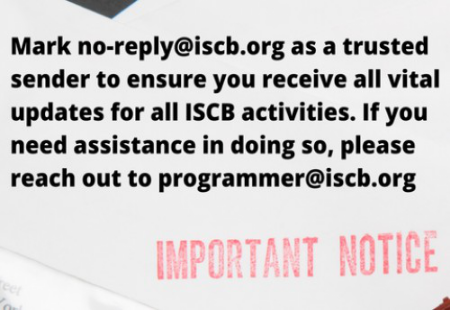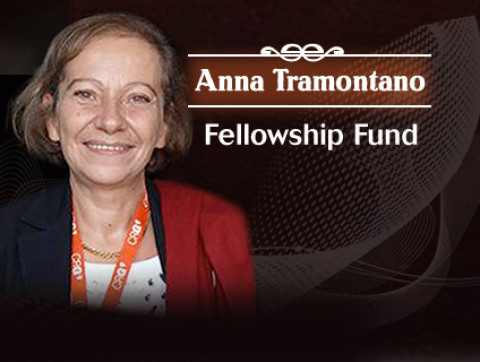Career Spotlights: Inspirational Stories from Computational Biology
Judith Blake, Professor
What training did you receive to prepare you for this position?
Ph.D.
Do you get further training on the job?
Not specifically; more involvement in development of new methods and procedures as part of human genome project and related bioinformatics efforts.
How do you make sure your knowledge stays current?
Everything is new in what do. Attend presentations, collaborate with others to advance the field.
Are you still in the primary field where you received your academic training?
Yes
Did you ever make a career change?
Yes
What led to the change in career? Do you have any tips for making a career change?
Well somewhat, from evolutionary biology using molecular techniques to comparative and functional analysis reflective of new genomics information streams
What do you know now that you wish you’d known when you started out down this career path?
How much social interactions play a role in scientific advances and support
What, if anything, else would you like to tell us about your career in bioinformatics?
sometimes have to let go of legacy implementations of resources and knowledge representations
What was the biggest obstacle you've faced in your career as a bioinformatician?
Lack of recognition of bioinformatics as a research area worthy of academic faculty consideration....
What advice do you have to give to new/entering bioinformaticians?
Follow the questions that interest you.learn what you to so to answer the big questions. nothing will stay the same, so keep learning new things. consider the completeness of the data you are working with in interpreting the output of programs.
Predrag Radivojac, Professor
What training did you receive to prepare you for this position?
Ph.D. in computer science, prior education in Electrical Engineering. Post-doc in comp bio.
Do you get further training on the job?
No.
How do you make sure your knowledge stays current?
Constant struggle, but a variety of methods. Reading papers, reviewing papers (increasingly) and grants, editing papers all help. Word of mouth. More recently I pick up things on social media and sometimes go down the rabbit hole of reading stuff.
Are you still in the primary field where you received your academic training?
Yes
Did you ever make a career change?
Yes
What led to the change in career? Do you have any tips for making a career change?
My job is the same, but I did switch institutions. Still a big change with adjustments necessary and proving yourself all over again. What prompted me was that I was approached by my current institution, but looks like I was ready to move on.
What do you know now that you wish you’d known when you started out down this career path?
I heard of many things but didn't understand them until I felt them. What surprised me was the extent to which science is effected by hype, self-promotion, and short attention span of the entire community.
What, if anything, else would you like to tell us about your career in bioinformatics?
My career in the field started randomly. My advisor had an RA position on a new grant and I was happy to give it a shot. It opened my eyes and I've been in the field ever since. It's sort of embarrassing that my first goal was other than bioinfo.
What was the biggest obstacle you've faced in your career as a bioinformatician?
Difficulty to fit in conventional depts or institutional groupings. My CS colleagues think I am a biologist and biologists often think I am just a computer scientist. Difficulty in recruiting students is a consequence of the still existing silos.
What advice do you have to give to new/entering bioinformaticians?
There are many ways to be successful in the field, yours might be unique. Be motivated by contributing to science much more than by potential success if you do it well. Allow others to change your views on what good science is, you won't regret that.
Hui Cai, Scientific SDET
What training did you receive to prepare you for this position?
PhD in Molecular Biology
Do you get further training on the job?
Computer Science, Bioinformatics
How do you make sure your knowledge stays current?
Learn everyday from hands-on tasks, take occasionally online courses
Are you still in the primary field where you received your academic training?
Yes
Did you ever make a career change?
No
What do you know now that you wish you’d known when you started out down this career path?
I wish that I knew computer skills are critical, so I could have learned them early on
What was the biggest obstacle you've faced in your career as a bioinformatician?
Get software engineers to understand certain issues in the product are critical
What advice do you have to give to new/entering bioinformaticians?
Learn new things everyday
Russel Schwartz, Professor
What training did you receive to prepare you for this position?
I received in PhD in Computer Science, but on work in computational biophysics. I also did postdoctoral work largely on problems in data analysis and spent two years in industry working on computational biology related to sequencing and genetic variation analysis before becoming a professor.
Do you get further training on the job?
Formal training on the job is largely on professional rather than strictly technical topics. This includes training in effective teaching and advising, as well as training required for regulatory compliance on research I do, such as in data security or protections for human research subjects.
How do you make sure your knowledge stays current?
My technical training is largely self-driven at this point, including reading current literature in my area and related fields, attending conferences, and attending seminars at my own institution, as well as other independent reading as needed.
Are you still in the primary field where you received your academic training?
Yes
Did you ever make a career change?
Yes
What led to the change in career? Do you have any tips for making a career change?
I have moved from industry to academia and between various subfields in each, although always in computational biology. There are many career paths by which one can make valuable contributions to science, so my best advice would be to keep an open mind and follow where the science takes you.
What do you know now that you wish you’d known when you started out down this career path?
I wish I had had more training in how to teach and to manage people before I started as a professor instead of having to figure out a lot for myself. The technical landscape is always changing and there are topics I wish I had known better starting out, but that is just the nature of science.
What, if anything, else would you like to tell us about your career in bioinformatics?
I probably did not appreciate enough early on the many ways one can make a difference in science. I am proud of the work I have done as a researcher, but I have learned to appreciate much more the impact one can make as an educator, administrator, advisor, advocate, policy-maker, etc.
What was the biggest obstacle you've faced in your career as a bioinformatician?
At least as a US-based academic researcher, I have found that the biggest obstacle to getting good science done is the outsized amount of effort one has to devote to raising money to support the science and the ways that process can sometimes stifle the most innovative and important directions.
What advice do you have to give to new/entering bioinformaticians?
This is a field rich with great problems that is only going to grow in importance over time. I would recommend that you never stop learning and always keep an open mind about how you can contribute to the science and by what career path you pursue it.
Patricia M. Palagi, Team Leader, SIB Training
What training did you receive to prepare you for this position?
I have obtained a BSc in Biology and a MSc in Computational Sciences, both from the University of Brasilia (Brazil). I have then obtained a PhD in Cognitive Sciences from the INPG-Grenoble. I think all those have contributed to this position, but were not intentionally targeted for this position.
Do you get further training on the job?
Yes, I have received training on time management, project management, leadership and management.
How do you make sure your knowledge stays current?
I attend congresses, eg ISMB, ECCB, BC2, and I read scientific articles. I'm also involved in Training/Education communities (ISCB Education COSI, ELIXIR Training, GOBLET). I’m also Deputy Editor of the Education track of PLoS CB journal. All those are endless sources of knowledge and inspiration.
Are you still in the primary field where you received your academic training?
Yes
Did you ever make a career change?
Yes
What led to the change in career? Do you have any tips for making a career change?
I had 2 main career changes in my life: 1st from being a plant pathologist to a computer scientist, 2nd from being a scientist, those who carry own research, to become an Education and Training leader. My tips: follow your heart, your instinct, be open to new opportunities and give them a try.
What do you know now that you wish you’d known when you started out down this career path?
I wished I knew that teaching and facilitating teaching could be so joyful and enlightening. I had this biased view that I could only be happy by being a scientist.
What, if anything, else would you like to tell us about your career in bioinformatics?
There is one thing that I miss from being a bioinformatician and that thing is coding. I miss spending hours searching that little bug in my code!
What was the biggest obstacle you've faced in your career as a bioinformatician?
My biggest obstacle was to be confronted along my career with people who can be toxic and compelled to prove their superiority by crushing their colleagues. Luckily there weren't many, and I also was surrounded by empathic and caring mentors who compensated.
What advice do you have to give to new/entering bioinformaticians?
Network and learn from others. Share your ideas, code, research results with others. In other words, be Open and FAIR, and here I mean in the scientific and human sense of these terms.
Francisco De La Vega, Vice President of Hereditary Disease
What training did you receive to prepare you for this position?
Doctor of Science degree in Genetics and Molecular Biology; Executive Certificate in Management and Leadership (MIT) later in career.
Do you get further training on the job?
Industry jobs regularly provided leadership, management, and product development process trainings
How do you make sure your knowledge stays current?
Following science Twitter; review TOC from top journals, attended relevant conferences
Are you still in the primary field where you received your academic training?
Yes
Did you ever make a career change?
Yes
What led to the change in career? Do you have any tips for making a career change?
From academia to industry early on my career
What do you know now that you wish you’d known when you started out down this career path?
Industry development processes; financial skills to manage budgets and understand valuation of technologies; project management skills.
What, if anything, else would you like to tell us about your career in bioinformatics?
Technolgy development drives directions of research and new products. As new technologies become available and scale up everyone shifts to leverage these data streams. One needs to be always aware of what new technology is emerging to take advantage of such shifts in advancing one's career.
What was the biggest obstacle you've faced in your career as a bioinformatician?
Be present and considered at the inception of projects to ensure a proper study design and that the necessary data and metadata are collected to improve outcomes.
What advice do you have to give to new/entering bioinformaticians?
Industry is a viable and rewarding career alternative. As such try ti explore early on, e.g. via internships to appreciate and make an informed decision on career choices.
Alex Bateman, Head of Protein Sequencing Resources
What training did you receive to prepare you for this position?
Throughout my career I have had access to very good management training, which has been essential to manage and prioritise the wide variety of tasks at hand.
Do you get further training on the job?
One of the reasons that I became a scientist was to discover things for myself. I really like to learn while doing something. If I get stuck I'll ask someone for advice.
How do you make sure your knowledge stays current?
I simply embrace my ignorance. As Ernest says in the Admirable Crichton, "I'm not young enough to know everything". Working with students is a great way to learn about new areas.
Are you still in the primary field where you received your academic training?
Yes
Did you ever make a career change?
No
What do you know now that you wish you’d known when you started out down this career path?
Spend less time worrying about things you cannot change.
What, if anything, else would you like to tell us about your career in bioinformatics?
As a former Director of Graduate studies I often told students they should travel internationally to get experience. I have never left the UK, or even Cambridge for my work. Draw your own conclusions.
What was the biggest obstacle you've faced in your career as a bioinformatician?
My own fear of failure has led me to not take risks and perhaps missing some interesting opportunities. I will not step into something new unless I have a strong conviction it is important.
What advice do you have to give to new/entering bioinformaticians?
Make sure you work on an important problem and be able to explain why it is important.

























